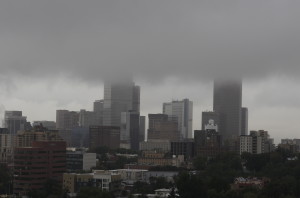Rain's Effect on Rivers and Fish
Colorado has become unrecognizable. If one were to take a look out of their window while flying into DIA they would see nothing but green, lush land for miles and miles. “Wait a minute,” the natives are thinking, “I haven’t seen anything like this in Colorado… this isn’t normal.” But it’s becoming the new normal thanks to persistent and consistent rain storms that have dominated the afternoons for the past month. Although May is usually Denver’s wettest, cloudiest month these storms have led to rainfall amounts that are far from the usual. So far in 2015 Denver has received more than 11 inches of rain, just a few inches shy of the total average yearly rainfall amount of 14 inches. All this rain is not entirely unwelcome. Too much water is still not enough water for Coloradans considering the fact we’re an extremely dry state and no stranger to droughts. Overflowing rivers and streams, hydrated agriculture, and plentiful amounts of water for cities is far superior to the severely water deprived lands states like California are currently suffering from. On the other hand, too much rain does not bode well for river and fish health.
More rain means more pollution ending up in our rivers due to runoff that picks up pesticides, sediment, bacteria, and other pollutants as it makes its way into our rivers. Bad bacteria and pollution could lead to oxygen depletion, or even hypoxic river conditions; conditions that are not conducive to healthy aquatic environments.
The sudden influx of water also creates rivers with a much higher velocity than is normal. According to USGS, the South Platte River is flowing at 782 percent of its normal flow, and the Cache La Poudre is flowing at 702 percent. These high river flows due to rain could be a symptom of climate change. The usual source of water for Colorado’s rivers is snowmelt, but as temperatures rise and snowpack lessens in the lower mountains (below 8200 ft.) it’s possible rain could become a new water source. However, A report done for the Colorado Water Conservation Board (click here for full report) states that as of right now it’s difficult to tell whether average annual precipitation will increase or decrease within the next 35 years. Due to high variability, determining whether long-term trends in annual precipitation are changing is nearly impossible right now, so this year’s immense rain falls could just be a temporary anomaly. That being said, it’s important for anglers to recognize that changes in water sources are quite possible.
Water flowing at high rates due to rain means the river turns into a muddy mess, which disrupts trout activity. Trout are water snobs; they thrive in cold, high quality, extremely clean water (as stated in Trout Unlimited’s State of the Trout article, the full article can be found here), the likes of which this rain does not produce. However…
Not all hope for good trout fishing is lost. With the rain comes some benefits as well. When rain falls on water, it oxygenates it, which brings life back into the river and raises trout activity levels. Rain also allows for bugs to be washed into the rivers, piquing the trouts interest and making them more likely to bite. Another bonus? Rain regulates the water temperature, and adds humidity to the air which is conducive to hatch activity.
